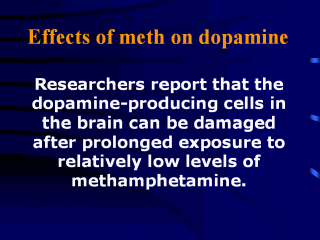 |
As you saw in the previous slides, meth affects
the brain structures, most notably the structures that contain dopamine.
Dopamine is the feel-good chemical that helps you feel good about
everything. Meth and dopamine molecules are similar in shape, size, and
chemical structure. Because of this, meth is able to fool the brain into
releasing lots of dopamine, causing the person a distorted sense of pleasure
that can last all day. Memory of the intense euphoria is the biggest hurdle
in overcoming methamphetamine addiction. But as the pleasurable effect
stops, it is followed by unpleasurable panic and fear (the crash) that leads
a person to want more of the drug. After each use, the amount of dopamine
released diminishes, as does the feeling of pleasure.
|
